Kidney Protection Hydration Calculator
Personalized Hydration Plan
This tool calculates your recommended hydration protocol based on kidney function and scan type. Results are based on current medical guidelines for contrast-induced acute kidney injury (CI-AKI) prevention.
When you’re scheduled for a CT scan, angiogram, or other imaging test that uses contrast dye, most people focus on the procedure itself - what to wear, how long it’ll take, whether they’ll feel anything. But few realize that the real risk might come after the test, not during. The dye used in these scans can damage your kidneys, especially if you already have kidney trouble, diabetes, or heart disease. This isn’t rare. About 1 in 10 high-risk patients develop acute kidney injury after contrast exposure. The good news? You can significantly reduce that risk - and it starts with something simple: hydration.
Why Hydration Matters for Your Kidneys
Your kidneys filter waste from your blood, and they’re especially sensitive to sudden changes in fluid balance. Contrast dye is thick and can temporarily reduce blood flow to the kidneys. When you’re dehydrated, your kidneys have to work harder to push that dye out. That stress can cause tiny structures inside the kidneys - the tubules - to get damaged. That’s called contrast-induced acute kidney injury (CI-AKI). It’s not always obvious. You might not feel sick. But your creatinine levels will rise, and you could end up in the hospital for days longer than planned. Studies show CI-AKI adds an average of 3.2 days to your hospital stay and costs about $7,500 extra per case. That’s not just a medical issue - it’s a financial one too. But here’s the key point: hydration isn’t just a suggestion. It’s a proven shield. When done right, it can cut your risk of kidney injury by more than half.What Hydration Plans Actually Look Like
Not all hydration is the same. You can’t just drink a big glass of water and call it done. The timing, type, and amount matter - a lot. The most common method is intravenous (IV) saline. For most high-risk patients, that means getting 0.9% sodium chloride (normal saline) at a rate of 3-4 mL per kilogram of body weight per hour. That’s usually given for 4 hours before the scan and 4 hours after. For example, if you weigh 70 kg, you’d get about 210-280 mL per hour. That’s roughly one full water bottle every 20-30 minutes, continuously. There’s also a longer version: 1 mL/kg/hour for 12 hours before and 12 hours after. This is often used for patients with advanced kidney disease. But it means you’re tied to an IV pole for most of a day. Another option is sodium bicarbonate. Instead of plain saline, you get a solution that makes your blood slightly more alkaline. This helps protect kidney cells from the dye’s toxic effects. The protocol is usually 154 mmol/L sodium bicarbonate at 3 mL/kg/hour for 1 hour before, then 1 mL/kg/hour for 6 hours after. Studies show it’s as effective as saline - maybe even better for some people. Then there’s the advanced stuff. The RenalGuard system is a closed-loop device that monitors your urine output in real time and automatically adjusts your IV fluids to keep you peeing at a steady 150-200 mL per hour. It sounds high-tech, and it is. But it’s also the most effective. In large studies, it cut CI-AKI rates from over 20% down to just 7% in high-risk patients.Oral Hydration: Is Drinking Water Enough?
You might be thinking: Can’t I just drink water? The answer is: sometimes, yes. Multiple studies have shown that for many people - especially those with mild kidney issues - drinking water works just as well as IV fluids. The typical plan: 500 mL (about 2 cups) of water 2 hours before the procedure, then 250 mL (1 cup) every hour during and after the scan. One large trial found CI-AKI rates of 4.7% with oral hydration versus 5.1% with IV - no meaningful difference. But here’s the catch: this only works if you’re not vomiting, not nauseous, and not severely dehydrated to begin with. If you’re already struggling with kidney function, your body might not absorb or hold onto water the way it should. That’s why IV is still the gold standard for high-risk patients - those with eGFR under 60 mL/min/1.73m², diabetics, or people with heart failure.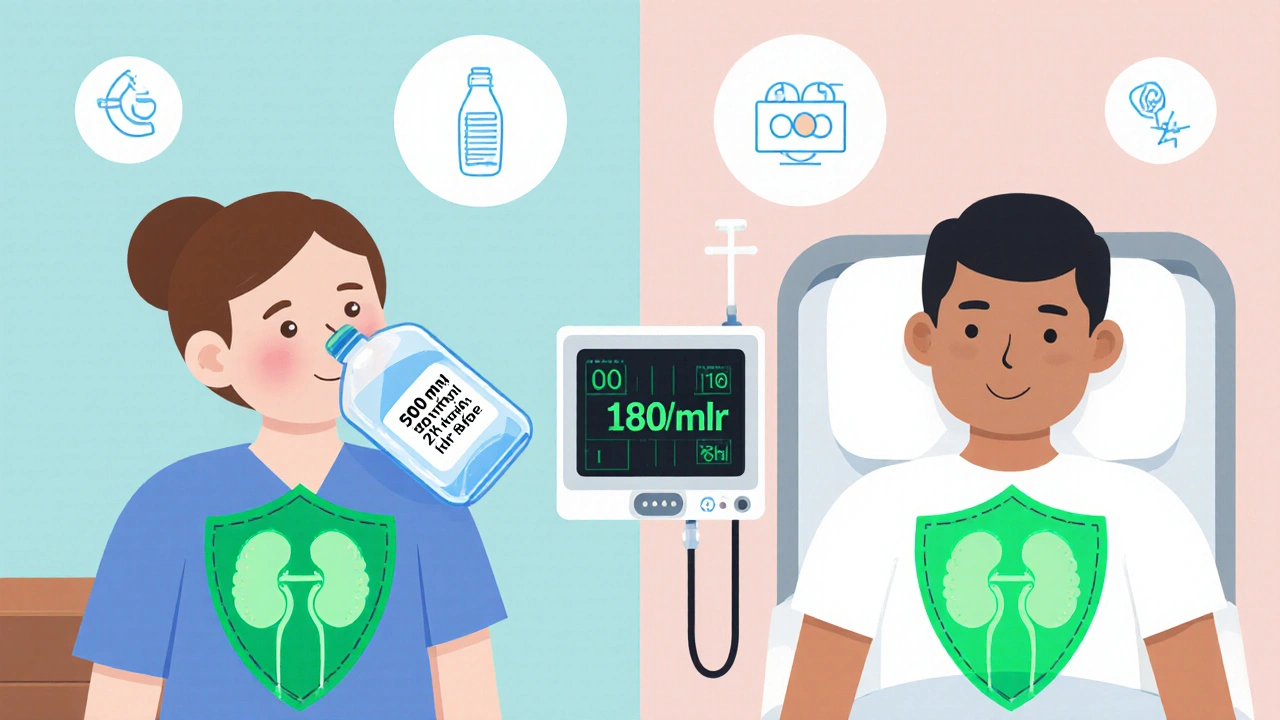
Who Needs It - and Who Doesn’t
Not everyone needs a hydration plan. That’s the big shift in modern guidelines. If your kidney function is normal - say, eGFR above 60 - you probably don’t need any special hydration before a routine scan. The 2018 eClinicalMedicine study showed that patients with eGFR above 29 mL/min/1.73m² had no increase in kidney injury when they skipped IV hydration. That’s a game-changer. It means thousands of low-risk patients avoid unnecessary IVs, long waits, and hospital stays. But if your eGFR is between 30 and 59, you’re in the gray zone. The VA/DOD 2025 guideline says you should get isotonic fluids at 1-1.5 mL/kg/hour for 3-12 hours before and after the contrast. If your eGFR is below 30? That’s serious kidney disease. Doctors should question whether the scan is even necessary. Sometimes, an MRI without contrast or an ultrasound is safer. And don’t forget heart failure. This is where hydration gets tricky. Too much fluid can cause your lungs to fill up with water - pulmonary edema. A 2023 JACC review warned that even 500 mL extra can trigger decompensation in someone with weak heart muscle. That’s why doctors now use hemodynamic-guided hydration: they monitor your central venous pressure to make sure you’re getting just enough fluid - not too much.What Hospitals Are Doing Right (and Wrong)
Leading hospitals have made hydration part of their standard workflow. The Mayo Clinic, for example, reduced CI-AKI rates from 12.3% to 5.7% in just one year by creating a checklist: check kidney function within 30 days before the scan, assign hydration protocol based on eGFR, document fluid intake and output, and recheck creatinine 48-72 hours after. But not every hospital has the resources. Advanced systems like RenalGuard cost about $1,200 extra per case. Many community hospitals still rely on basic IV saline because they can’t afford the equipment. That’s fine - as long as they’re consistent. The biggest mistake? Skipping the pre-procedure kidney test. If you don’t know your eGFR, you can’t personalize the plan. And that’s how people get hurt.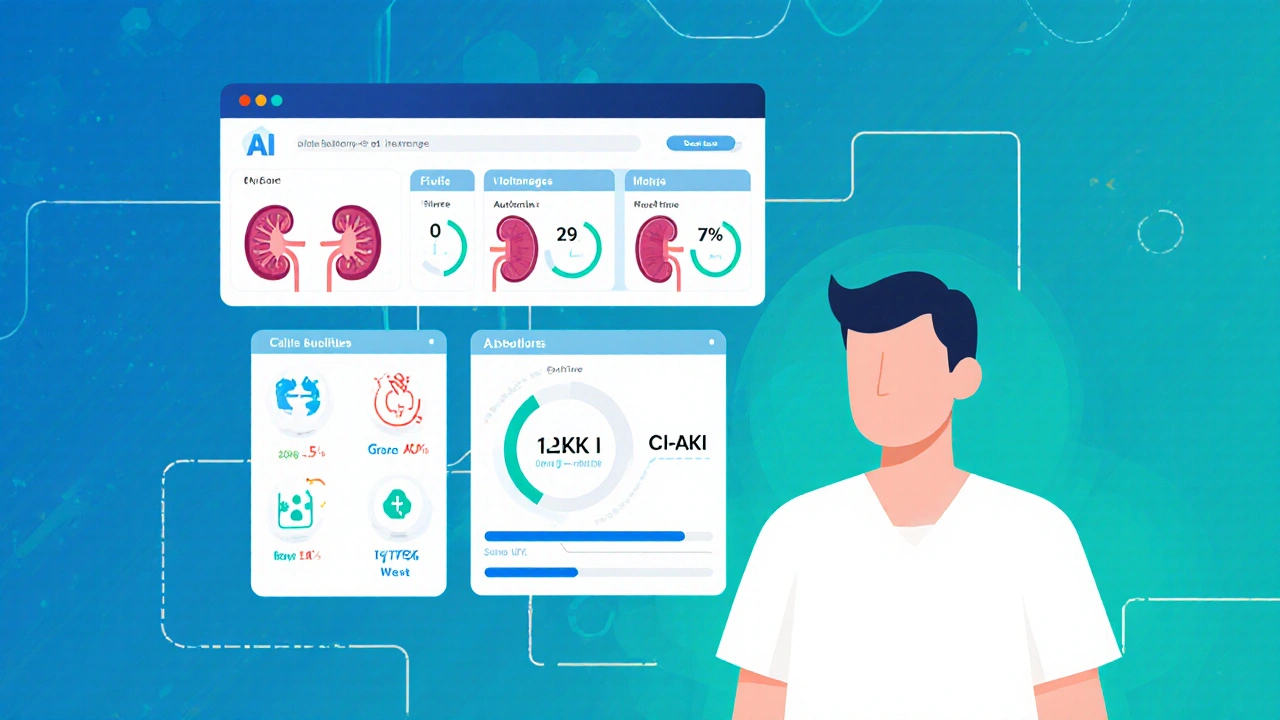
What You Can Do
You don’t need to be a doctor to protect your kidneys. Here’s what you can do before your next imaging test:- Ask your doctor: “What’s my eGFR?” If you don’t know, get a blood test before the scan.
- Ask: “Do I need IV fluids, or is drinking water enough?”
- If you’re told to drink water, start 2 hours before. Don’t wait until the day of.
- If you’re on IV fluids, make sure someone is tracking how much you’re getting - and how much you’re peeing out.
- After the test, keep drinking water for the next 24 hours. Don’t stop just because the scan is over.
The Future: Smarter, Personalized Hydration
The next big step isn’t just more fluids - it’s smarter fluids. Researchers are testing real-time biomarkers that show kidney stress before creatinine rises. Imagine a test that tells your doctor, “Your kidneys are under strain right now - increase the drip.” The American Heart Association predicts that within five years, AI-driven systems will adjust hydration automatically based on your weight, kidney function, heart status, and even your urine output in real time. Pilot programs at Johns Hopkins are already showing 15-20% further reductions in kidney injury with these systems. The goal isn’t to give everyone the same amount of water. It’s to give you exactly what your body needs - no more, no less. That’s the future of kidney protection.Do I need to drink water before a CT scan with contrast?
Yes - but how much and how you get it depends on your kidney health. If your eGFR is above 60, drinking 500 mL of water 2 hours before the scan is usually enough. If your kidney function is reduced (eGFR below 60), your doctor may recommend IV fluids instead. Never assume you don’t need hydration - always ask.
Can drinking too much water harm my kidneys?
In healthy people, drinking extra water before a scan is safe and helpful. But if you have heart failure or severe kidney disease, too much fluid can overload your system and cause swelling or trouble breathing. That’s why hydration plans are personalized. Your doctor will choose the right amount based on your health history.
Is IV hydration better than drinking water?
For people with moderate to severe kidney disease (eGFR below 60), IV hydration is more reliable because it ensures you get the exact amount needed. For those with mild or no kidney issues, drinking water works just as well. Studies show no significant difference in kidney injury rates between oral and IV hydration in low-risk patients.
How long after a CT scan should I keep drinking water?
Continue drinking water for at least 24 hours after the scan. Your kidneys are still working to flush out the contrast dye. Staying hydrated helps prevent delayed kidney injury. If you’re on IV fluids, the medical team will usually keep you on them for 4-12 hours after the procedure, depending on your risk level.
Should I take NAC (N-acetylcysteine) to protect my kidneys?
No - not if you’re already well-hydrated. Multiple studies, including a 2020 meta-analysis of over 21,000 patients, found that NAC doesn’t lower the risk of kidney injury when hydration is adequate. It adds cost and side effects (like nausea) without benefit. Only take it if your doctor specifically recommends it for a different reason.
What if I have diabetes and need a contrast scan?
Diabetes increases your risk of kidney injury from contrast dye. You should always have your eGFR checked before the scan. If it’s below 60, you’ll likely need IV hydration. Avoid metformin for 48 hours after the scan if your kidney function is low - it can build up in your blood and cause lactic acidosis. Your doctor will guide you on when to restart it.


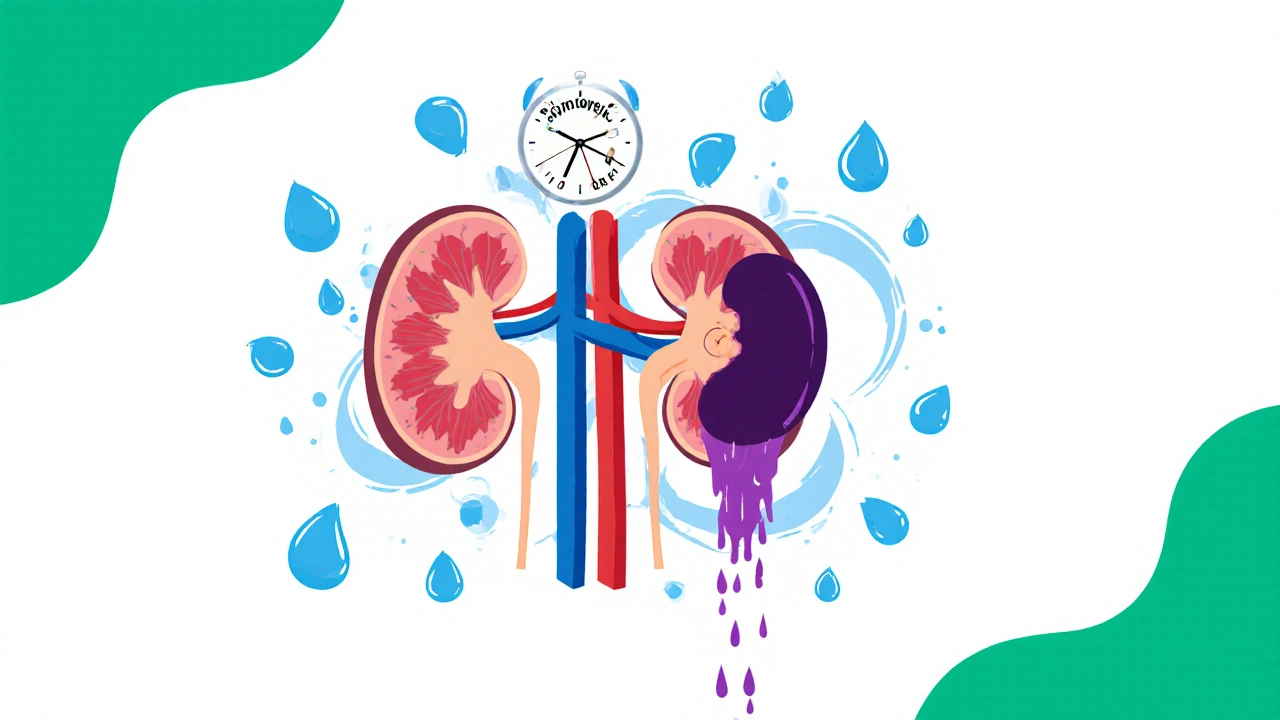
 Medications
Medications
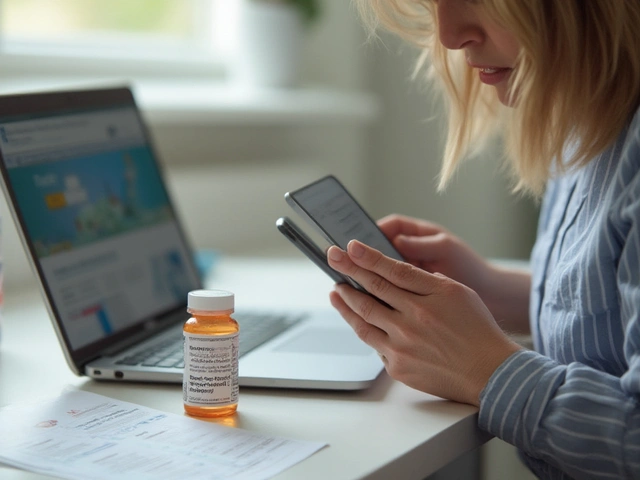
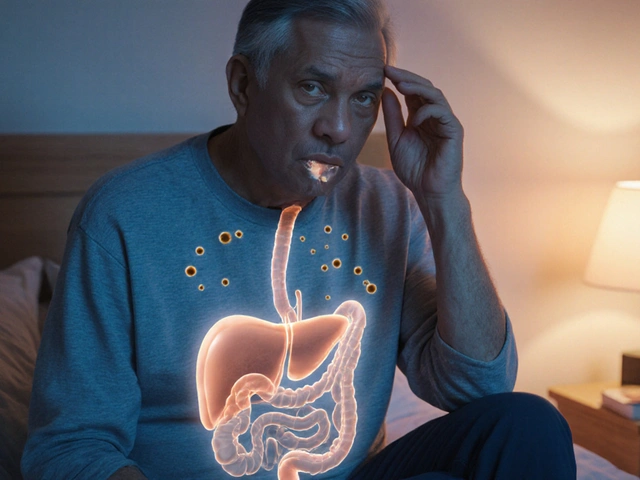

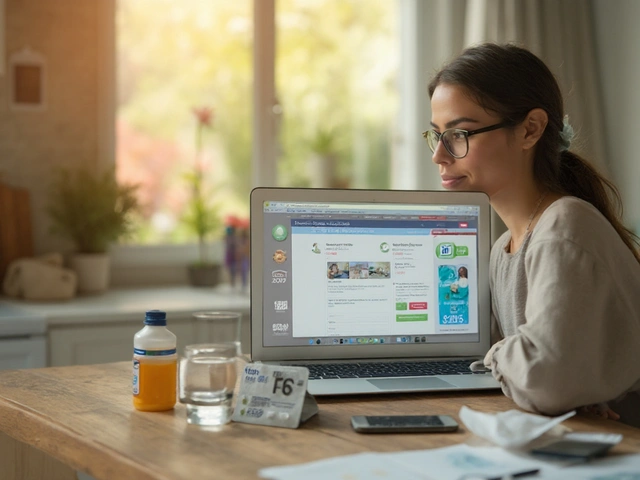
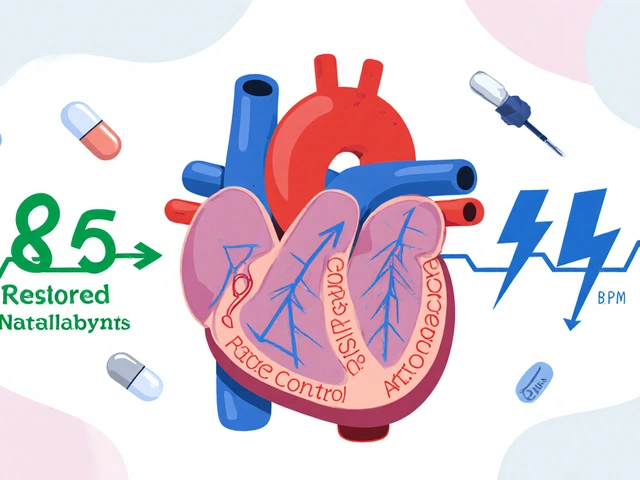
Laurie Sala
November 23, 2025 AT 10:45OMG, I just had a CT scan last week and they didn't even ask me about my kidneys!! I'm diabetic and I just drank a bottle of water like a good girl... but now I'm terrified I'm gonna need a transplant??
Richard Wöhrl
November 23, 2025 AT 23:31Let me clarify this because I've seen too many people panic over this: if your eGFR is above 60, you're fine with oral hydration. IV fluids are overkill for low-risk folks. The real danger is when hospitals skip the pre-scan kidney test-then everyone gets the same protocol, and that's where things go sideways. Also, NAC? Waste of money if you're hydrating properly. I've worked in radiology for 18 years. This isn't theory-it's daily practice.
Pramod Kumar
November 24, 2025 AT 06:42Bro, this is one of those rare posts where the science actually matches real life. I'm from a small town in India where most folks don't even know what eGFR means. We've got a local clinic that started doing pre-scan kidney checks last year-and guess what? Their CI-AKI rates dropped like a rock. People thought it was just 'extra paperwork'-until Mrs. Desai, 72, diabetic, had her scan and walked out without a single hospital stay. Now they've got a poster: 'Check Your Kidneys Before Your Scan.' Simple. Powerful. I wish every hospital in the world had that poster.
Brandy Walley
November 24, 2025 AT 21:40shreyas yashas
November 26, 2025 AT 13:14Man, I used to think drinking water before a scan was just a hospital thing to keep you busy. But last year, my dad had an eGFR of 48, and they gave him IV fluids for 8 hours before and after. He didn't even feel weird after. I thought he'd be swollen or something-but nope. Just chilled. Turns out, your body knows what it needs if you just give it the right tools. No magic pills, no drama. Just water. Or saline. Whatever works.
Suresh Ramaiyan
November 27, 2025 AT 07:04There's something beautiful here about how medicine is slowly moving from one-size-fits-all to personalized care. We used to treat kidneys like a faucet-you turn the water on, and hope it flushes out the junk. Now we're learning to listen. To measure. To adjust. The RenalGuard system? It's not just tech-it's respect. Respect for the body's signals, for the patient's history, for the fact that we're not all the same. This isn't just about preventing injury. It's about honoring how complex we are.
Katy Bell
November 28, 2025 AT 22:42Okay but can we talk about how weird it is that we don't just tell people this stuff BEFORE they book the scan? Like, imagine getting a call: 'Hey, your eGFR is 52. Here's your hydration plan. Bring a book. You'll be here 12 hours.' That would change everything. Instead, we're all just scrambling at the front desk like, 'Wait, I need to drink what??'
Ragini Sharma
November 29, 2025 AT 09:39so i read this whole thing and now i'm like... wait, so i dont need to chug 2 liters of water before my mri? lol i thought i was being so healthy. also, why does every doctor say 'drink water' like its a magic spell? its not. its science. and i'm still confused but also kinda impressed??
Linda Rosie
November 29, 2025 AT 19:01Hydration protocols should be standardized across all imaging centers. Pre-procedure eGFR testing is non-negotiable. Failure to implement these measures constitutes a preventable clinical lapse. Patient outcomes improve demonstrably with protocol adherence.